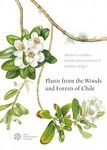Flora / Fauna Identification Key Monograph
Out of Print
By: James L Luteyn(Author)
290 pages, 78 b/w photos, b/w line drawings and b/w distribution maps
![Flora Neotropica, Volume 35: Ericaceae, Part 1: Cavendishia Flora Neotropica, Volume 35: Ericaceae, Part 1: Cavendishia]()
Click to have a closer look
About this book
Related titles
About this book
Cavendishia is a genus of neotropical shrubs numbering 100 species. It is one of the most easily recognizable vaccinioid genera because of its bright, showy flowers, usually enlarged floral bracts, and altemately unequal filaments and anthers. The genus is most abundant in the mountains of northwestem South America, especially Colombia where 63 species are recognized. A few species are widespread, but most are narrow endemics.
The need for a revision of Cavendishia has been apparent for many years. It was last treated as a whole by A.C. Smith as part of his larger monograph The American Species of Thibaudieae (Smith, 1932). Luteyn (1976) revised the Mexican-Central American species. Since 1932 numerous species have been described, especially from Panama and Colombia, but no key has been provided that incorporates these new taxa. Despite the showy nature of its flowers, the genus is still poorly collected: 16 species are known only from the type collection (19 only from the type locality), 30 from five or fewer collections, and 12 from only 6-10 collections. Areas in which new taxa undoubtedly will be found are the continental divide cloud forests of Panama and the western slopes of the Cordillera Occidental of Colombia. l have been fortunate to study 72 species in their natural habitats
during extensive fieldwork over the last seven years.
This treatment offers the first detailed account of vegetative anatomy, general morphology, pollen morphology, and chemotaxonomy (flavonoids and simple phenols) for any neotropical vaccinioid.
The plants are highly adapted for hummingbird pollination and bird dispersal. Hybridization occurs but does not seem to obscure specific lines.
Economically, Cavendishia has only local usage although several species have potential as crop plants or in horticulture. Indeed local usage as "floral bouquets" is clearly endangering the existence of several narrow endemics.
Customer Reviews
Flora / Fauna Identification Key Monograph
Out of Print
By: James L Luteyn(Author)
290 pages, 78 b/w photos, b/w line drawings and b/w distribution maps




















![Flora Neotropica, Volume 96: Drosera (Droseraceae) [Spanish]](http://mediacdn.nhbs.com/jackets/jackets_resizer_medium/15/158391.jpg?height=150&width=106)





![Gramineas de Bolivia [Gramineas of Bolivia]](http://mediacdn.nhbs.com/jackets/jackets_resizer_medium/81/81508.jpg?height=150&width=94)







![Costa Rica: Tropical Flowers [English / Spanish]](http://mediacdn.nhbs.com/jackets/jackets_resizer_medium/19/195410.jpg?height=150&width=64)








